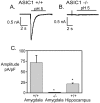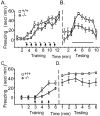Acid-sensing ion channel 1 is localized in brain regions with high synaptic density and contributes to fear conditioning
- PMID: 12843249
- PMCID: PMC6741257
- DOI: 10.1523/JNEUROSCI.23-13-05496.2003
Acid-sensing ion channel 1 is localized in brain regions with high synaptic density and contributes to fear conditioning
Abstract
The acid-sensing ion channel, ASIC1, contributes to synaptic plasticity in the hippocampus and to hippocampus-dependent spatial memory. To explore the role of ASIC1 in brain, we examined the distribution of ASIC1 protein. Surprisingly, although ASIC1 was present in the hippocampal circuit, it was much more abundant in several areas outside the hippocampus. ASIC1 was enriched in areas with strong excitatory synaptic input such as the glomerulus of the olfactory bulb, whisker barrel cortex, cingulate cortex, striatum, nucleus accumbens, amygdala, and cerebellar cortex. Because ASIC1 levels were particularly high in the amygdala, we focused further on this area. We found that extracellular acidosis elicited a greater current density in amygdala neurons than hippocampal neurons and that disrupting the ASIC1 gene eliminated H+-evoked currents in the amygdala. We also tested the effect of ASIC1 on amygdala-dependent behavior; ASIC1-null mice displayed deficits in cue and context fear conditioning, yet baseline fear on the elevated plus maze was intact. These studies suggest that ASIC1 is distributed to regions supporting high levels of synaptic plasticity and contributes to the neural mechanisms of fear conditioning.
Figures








References
-
- Bianchi L, Driscoll M ( 2002) Protons at the gate: DEG/ENaC ion channels help us feel and remember. Neuron 34: 337–340. - PubMed
-
- Bolshakov KV, Essin KV, Buldakova SL, Dorofeeva NA, Skatchkov SN, Eaton MJ, Tikhonov DB, Magazanik LG ( 2002) Characterization of acid-sensitive ion channels in freshly isolated rat brain neurons. Neuroscience 110: 723–730. - PubMed
Publication types
MeSH terms
Substances
Grants and funding
LinkOut - more resources
Full Text Sources
Other Literature Sources
Molecular Biology Databases
